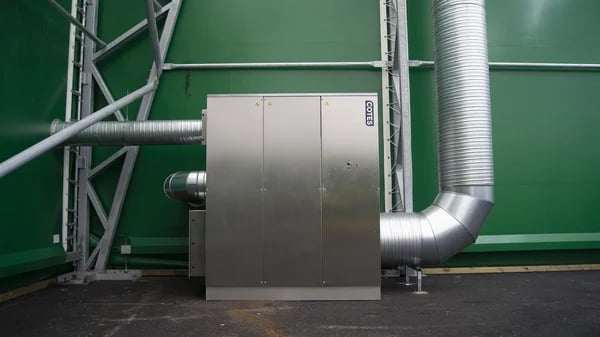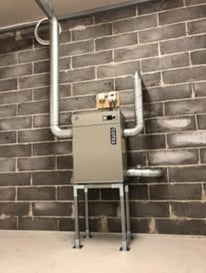THE CHALLENGES OF STORING IRON AND STEEL
Because of their high sensitivity to humidity and potential for corrosion, the importance of the correct dry-air conditions for storing iron and steel cannot be emphasized enough. Fluctuations in the external weather conditions and changes to indoor temperatures can cause the conditions inside storage facilities to fluctuate day by day. Fluctuating temperatures combined with high relative humidity will result in condensation, which can lead to:
- Corrosion on iron and steel rolls, plates, girders or semi-finished products
- Reduced value of the stored materials
- Increased operating costs
- Customer complaints and compensation payments
- Increased warranty claims
CREATING SUITABLE CONDITIONS FOR STEEL AND IRON
Relative humidity (RH) is one of the main contributing factors for the corrosion of iron and steel. When storing these materials, it is important to significantly slow down the corrosion process to prevent visible corrosion which if not prevented, can result in costly write-offs. Research shows that the lower the relative humidity, the slower the corrosion of metal goods (|SO 9223, 2012). Regulating relative humidity in the storage facilities makes it possible to store iron and steel for years without any visible corrosion, thus prolonging the lifetime of these valuable materials.
HOW IS HUmidiTY CONTROLLED IN STORAGE FACILITIES?
If you know the moisture content in the air and the temperature, you know relative humidity. And if you know the moisture content, it is easy to find the dew point - the temperature at which water vapour in the air condensates. Relative humidity can be altered by:
- Increasing the inside temperature - with higher temperatures and at a constant moisture content, the relative humidity will decrease. However, this is not a sustainable solution, especially in large storage facilities where it would be cost-ineffective to keep temperatures at high levels.
- Altering the moisture content and the dew point temperature - this is best achieved by the process of dehumidification, which is a sustainable and effective solution for controlling the relative humidity and avoiding related issues.
Dehumidification makes it possible to avoid corrosion forming on iron and steel while in storage by regulating relative humidity in the facility, thus eliminating condensation from forming on the stored materials.
THE BENEFITS OF DRY AIR
The main benefit of dry air is the prevention of condensation and therefore the prevention of corrosion. This leads to other related benefits:
- Maintaining the value of the iron and steel by minimising damage
- Preventing corrosion from forming on the structures, fittings and equipment in the facility
- Fewer customer complaints and more satisfied customers
- Minimising costly write-offs, compensation payments and insurance claims
The above-mentioned benefits of keeping humidity under control in iron and steel storage facilities also contribute to significant cost savings. As well as reducing compensation payments and write-offs, maintenance and building service costs are kept to a minimum. Other indirect but important advantages of using a dry-air solution in iron and steel storage facilities are hygiene and safety. The absence of condensation means avoiding the growth of mould and bacteria which creates and maintains a safer workplace. Corrosion-free structures, fittings and equipment maintain their quality and stability, contributing to the overall safety of the facility.
HOW COTES SOLUTIONS STAND OUT
- Excellent control abilities to suit the specific requirements of your iron and steel storage facility
- Designed to be resilient with a long service life
- Compact, robust and reliable
- Capacity to remove high levels of moisture from large volumes of air
- High rate of return on investment
Video: The process of adsorption dehumidification
THE RIGHT DEHUMIDIFIERS FOR THE JOB
The Cotes C-range adsorption dehumidifiers are the most cost-effective choice for meeting the humidity requirements for the storage of metal and alloys such as iron and steel. Their add-on modules are highly costumisable to fit with your specific business model.
The first step in identifying which Cotes adsorption dehumidifier will fit the specific requirements of your iron and steel storage is to identify the volume of the storage space and the amount of humidity that needs to be removed from the air. Our range of dehumidifiers is designed to adapt to different requirements. The images below show two different dehumidification systems used in different iron and steel storage facilities, installed by one of Cotes' partners - Anders Nilsson illustrating the versatility of the Cotes C-range dehumidifiers.
Do you have issues with humidity?
If you would like to determine whether you need a dry-air solution in your facilities or would like to explore what a custom dry-air strategy can do for your business, please reach out to one of our trusted partners near you.
References:
ISO 9223, 2012. Corrosion of metals and alloys — Corrosivity of atmospheres — Classification, determination and estimation. Published in Switzerland. Link: https://www.iso.org/standard/53499.html


